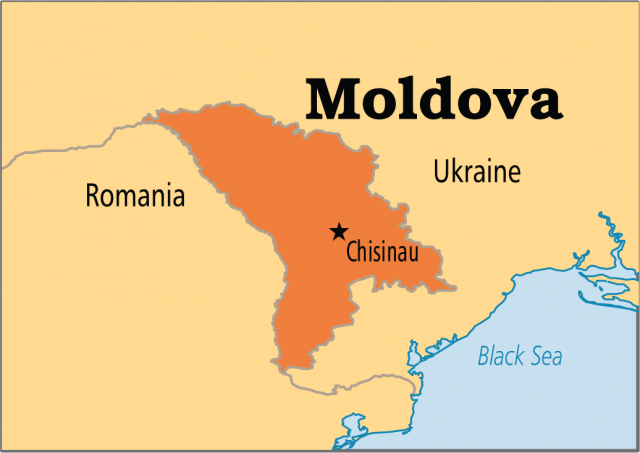Moldova
Area 13,067 square mi (33,843 square km)
Population 3.556 million 2014
Capital Chisinau
Highest Point 1,419 ft (430 m)
Lowest Point 6.6 ft (2 m)
GDP $7.944 billion 2014
Primary Natural Resources lignite, phosphorites, gypsum.
THE REPUBLIC OF MOLDOVA is the second-smallest former Soviet republic and the most densely populated, located in the borderlands between the UKRAINE and ROMANIA, to which it is linked ethnically and linguistically. It is actually only half of the area traditionally known as Moldavia; the western portion has been an integral part of ROMANIA since its independence from the Ottoman Turks in 1878.
The eastern portion, known as Bessarabia, lies between the rivers Prut and Nistra (Dniester in Russian) and has been passed back and forth among the Ottomans, RUSSIA, and Romania several times since the early 19th century. Independent since the breakup of the Soviet Union in 1991, many Moldovans wish for full union with their kindred in Romania, but this move has been blocked by Russians and by Romanians, who do not wish to antagonize their much larger neighbor. One of the reasons for this is the large number of Russians who live in Moldovan territory, on the eastern banks of the Dniester.

This region has proclaimed its independence from Moldova as the “Republic of Trans-Dniestria” (called Stinga Nistrului in Moldovan), and although it is de facto an autonomous state (with its own government and currency), no other nation recognizes its sovereignty, not even Russia, whose troops remain to “protect the peace” (after a short but bloody civil war in 1992). Moldova's boundaries also enclose another region that has been given extensive autonomy (in 1994), albeit much more peaceably, Gagauzia, home to a people who speak a Turkic language but converted to Orthodox Christianity centuries ago.
Moldova is LANDLOCKED, but only by a thin strip of land belonging to Ukraine (south of Odessa) that separates it from the BLACK SEA. Access to the sea is gained through the lower reaches of the Dniester and Moldova's tiny stretch of the DANUBE (0.4 mi or 0.7 km) at its confluence with the river Prut before it enters its broad DELTA. The Dniester River dominates the eastern portion of the country, at points forming the boundary with Ukraine. A major feature along this river is the 60-mi or 97-km lake, Dubossary, formed by a large hydroelectric dam built in the 1970s. Other Soviet hydrological projects included a plan to divert much of the water from the Dniester across southern Ukraine to the Dnieper and Bug rivers, but this was never constructed. Two medium-sized tributaries flow into the Dniester, the Reut and the Byk. The Byk flows past the capital, Chisinau (formerly Kishinev), which, although relatively small, was the third-fastest-growing city in the Soviet Union in the 1980s.
One of the poorest states in Europe, Moldova has nevertheless made economic progress through rapid privatization. One of the former Soviet Union's agricultural heartlands, Moldova's broad and fertile plains contain an abundance of rich farmland, but very few mineral resources, so the region remains reliant on Russia for oil, coal, and natural gas. The terrain is slightly hillier in the north, the start of low foothills descending from the Carpathian Mountains to the northwest, where the Prut and Dniester have their sources. The country's topography then declines in a gradual slope toward the Black Sea.
The climate is mostly temperate but becomes warmer and almost Mediterranean in the far south, allowing for cultivation of Moldova's most significant agricultural product, wine, which used to supply as much as one-third of the total wine sales in the Soviet Union. Much of this industry is concentrated in the autonomous Gagauzia region, in its capital, Comrat. Tobacco is also a major export crop, supplying the material for cigarettes for most of Eastern Europe and Russia. The rich black soil of the country's rolling plains (chernozem in Russian, among the most fertile soil in the world) are a great resource for potential growth.
The southernmost part of Moldova is the westernmost portion of the STEPPE that extends across southern Ukraine toward Central Asia. The land here is much drier but well-irrigated and easy to cultivate. The richness of this soil and the most favorable climate in the whole of the former Soviet Union (similar to the Crimea), have lured settlers and conquerors throughout history, one of the reasons Moldova is experiencing its independence for the first time.